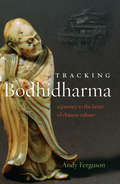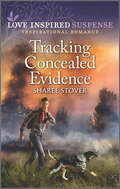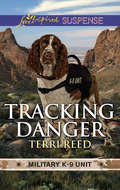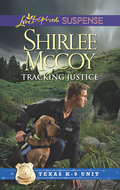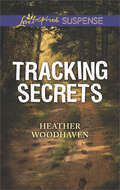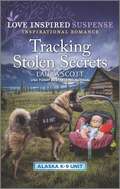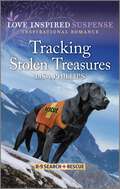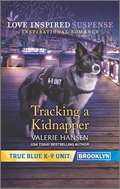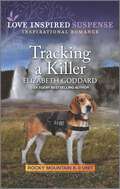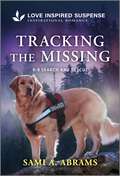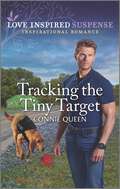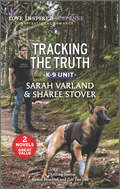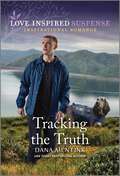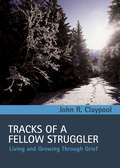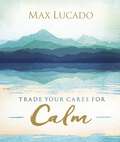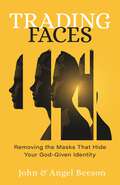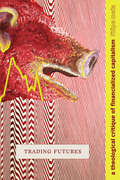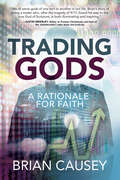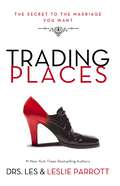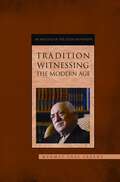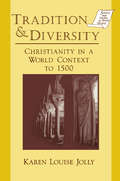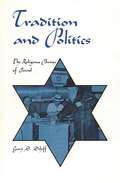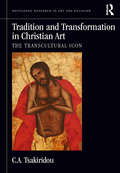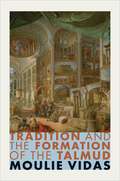- Table View
- List View
Tracking Bodhidharma: A Journey to the Heart of Chinese Culture
by Andy FergusonThe life of Bodhidharma, the founder of Zen Buddhism, has, with the passing of time, been magnified to the scale of myth, turning history into the stuff of legend. Known as the First Patriarch, Bodhidharma brought Zen from South India into China in 500 CE, changing the country forever. In Tracking Bodhidharma, Andrew Ferguson recreates the path of Bodhidharma, traveling through China to the places where the First Patriarch lived and taught. This sacred trail takes Ferguson deep into ancient China, and allows him to explore the origins of Chan [Zen] Buddhism, the cultural aftermath that Bodhidharma left in his wake, and the stories of a man who shaped a civilization.Tracking Bodhidharma offers a previously unheard perspective on the life of Zen's most important religious leader, while simultaneously showing how that history is relevant to the rapidly developing super-power that is present-day China. By placing Zen Buddhism within the country's political landscape, Ferguson presents the religion as a counterpoint to other Buddhist sects, a catalyst for some of the most revolutionary moments in China's history, and as the ancient spiritual core of a country that is every day becoming more an emblem of the modern era.
Tracking Concealed Evidence
by Sharee StoverUnearthing clues in a murder could be the last thing they do… To salvage his reputation, former forensic entomologist Jamie Dyer and his cadaver dog search for clues in a dismissed homicide—and find the victim&’s sister, Detective Shaylee Adler, buried alive. Convinced her senator brother-in-law is behind the attack on her and her sister&’s disappearance, Shaylee needs Jamie&’s expertise. But can they uncover a deadly conspiracy before the killer buries the case—and them—for good?From Love Inspired Suspense: Courage. Danger. Faith.
Tracking Danger (Military K-9 Unit)
by Terri ReedOn the hunt for a killerAn exciting prequel to the Military K-9 Unit seriesSheriff’s Deputy Serena Evans knows her trusty K-9 partner Ginger can track down the serial killer who is tormenting her Texas town…if only her boss would give her the chance. When they trace him to Jason Hargrove’s land, Serena and Ginger will have to team up with the reclusive rancher in order get their man.
Tracking Justice: Tracking Justice; Detection Mission; Guard Duty (Texas K-9 Unit #1)
by Shirlee MccoyIn the night, a young boy goes missing from his bedroom. Police detective Austin Black assures desperate single mother Eva Billows that he'll find her son. He has to, so he can put to rest his own harrowing memories. With his search-and-rescue bloodhound, Justice, Austin searches every inch of Sagebrush, Texas. And when Eva insists on helping, Austin can't turn her away. Eva trusts no one, especially police, but this time, Austin-and Justice-won't let her down.
Tracking Secrets: Bounty Hunter Fatal Cover-up Tracking Secrets (Mills And Boon Love Inspired Suspense Ser.)
by Heather WoodhavenA disgraced lawyer and a veterinarian are caught in the crosshairs of a deadly drug cartel in this electrifying thriller from the author of Credible Threat.A dog-sitting favor for a friend takes a terrifying twist when the police-dog-in-training runs off and leads Alexis Thompson into the middle of a drug drop. Only the quick thinking of a passing stranger gets them both out alive. Veterinarian Nick Kendrick, who’s running for mayor, knows the race for survival is just beginning. As moving targets, he and Alexis must work together to learn the identity of the drug ring’s murderous mastermind. But having killers on their tail isn’t the only problem they face. Alexis’s past as a disbarred lawyer could jeopardize Nick’s political future. Only by putting their dreams and their safety on the line can they eliminate the threat to their town, and find a way forward together . . .
Tracking Stolen Secrets (Alaska K-9 Unit #4)
by Laura ScottWith her K-9 partner&’s help,can they protect her infant niece? Positive her sister isn&’t involved in a theft ring as the police believe, State Trooper Helena Maddox and her K-9 partner must find her twin before local cop Everett Brand does. But when the niece Helena didn&’t know existed is left on Everett&’s doorstep, they all become targets. Now, working with Everett is Helena&’s only option to keep the baby safe and prove her sister&’s innocence…ALASKA K-9 UNITFrom Love Inspired Suspense: Courage. Danger. Faith.Alaska K-9 UnitBook 1: Alaskan Rescue by Terri ReedBook 2: Wilderness Defender by Maggie K. BlackBook 3: Undercover Mission by Sharon DunnBook 4: Tracking Stolen Secrets by Laura ScottBook 5: Deadly Cargo by Jodie BaileyBook 6: Arctic Witness by Heather WoodhavenBook 7: Yukon Justice by Dana Mentink
Tracking Stolen Treasures (K-9 Search and Rescue #10)
by Lisa PhillipsA criminal conspiracy. A kidnapped suspect. Can a K-9 team uncover the truth? To expose a vicious jewel-theft ring, undercover FBI agent Alena Sanchez pursues a prime suspect at a mountain resort. Only the woman vanishes—forcing Alena to team up with search and rescue officer Hank Miller and his K-9 to save her. But with the criminals setting lethal traps, Alena and Hank are running out of time to catch the culprits before they end up dead. From Love Inspired Suspense: Courage. Danger. Faith.K-9 Search and Rescue Book 1: Desert Rescue by Lisa PhillipsBook 2: Trailing a Killer by Carol J. PostBook 3: Mountain Survival by Christy BarrittBook 4: Search and Defend by Heather WoodhavenBook 5: Following the Trail by Lynette EasonBook 6: Dangerous Mountain Rescue by Christy BarrittBook 7: Wilderness Hunt by Lisa PhillipsBook 8: Alaskan Mountain Search by Sarah VarlandBook 9: Alaskan Avalanche Escape by Darlene L. TurnerBook 10: Tracking Stolen Treasures by Lisa PhillipsBook 11: Alaskan Wilderness Rescue by Sarah VarlandBook 12: Lethal Mountain Pursuit by Christy Barritt
Tracking a Kidnapper (True Blue K-9 Unit: Brooklyn #5)
by Valerie HansenFoiling a criminal’s plansmakes an officer and her K-9 partner targets.Thwarting a kidnapping has thrust Officer Vivienne Armstrong and her K-9 partner, Hank, right into the culprit’s crosshairs. Now, even with danger stalking them at every turn, Vivienne refuses to stop working, but FBI agent Caleb Black intends to do his job and safeguard her. Together, can they stop the would-be kidnapper from striking a final, fatal blow?USA TODAY Bestselling Author
Tracking a Killer (Rocky Mountain K-9 Unit #6)
by Elizabeth GoddardCan an officer and her furry partner survive a killer and the wilderness? When Rocky Mountain K-9 officer Harlow Zane and her cadaver dog, Nell, join the search for a serial killer, the last thing she expects is that she&’ll draw the killer&’s obsessive attention. But her former academy rival, FBI Special Agent Wes Grey, notices she matches the victim profile. After another look-alike goes missing, they must work together to catch the criminal…before Harlow&’s the next to disappear. From Love Inspired Suspense: Courage. Danger. Faith. Rocky Mountain K-9 Unit Book 1: Detection Detail by Terri ReedBook 2: Ready to Protect by Valerie HansenBook 3: Hiding in Montana by Laura ScottBook 4: Undercover Assignment by Dana MentinkBook 5: Defending from Danger by Jodie BaileyBook 6: Tracking a Killer by Elizabeth GoddardBook 7: Explosive Revenge by Maggie K. BlackBook 8: Rescue Mission by Lynette Eason
Tracking the Missing (K-9 Search and Rescue)
by Sami A. AbramsA search for three abducted teens— and a K-9 on the case. After surviving a vicious attack in the woods, Tori Campbell awakes to her worst nightmare—her son and his two friends are missing. She calls the one person she knows she can trust, her late husband&’s best friend, former DEA agent Michael Lane. Together with his search-and-rescue K-9, they must track the boys and figure out who took them—and why. Only, the Indiana wilderness is full of dangers beyond their abductor. Can Michael and Tori find the teens…even if it means falling into a sinister trap?From Love Inspired Suspense: Courage. Danger. Faith.K-9 Search and Rescue Book 1: Desert Rescue by Lisa PhillipsBook 2: Trailing a Killer by Carol J. PostBook 3: Mountain Survival by Christy BarrittBook 4: Search and Defend by Heather WoodhavenBook 5: Following the Trail by Lynette EasonBook 6: Dangerous Mountain Rescue by Christy BarrittBook 7: Wilderness Hunt by Lisa PhillipsBook 8: Alaskan Mountain Search by Sarah VarlandBook 9: Alaskan Avalanche Escape by Darlene L. TurnerBook 10: Tracking Stolen Treasures by Lisa PhillipsBook 11: Alaskan Wilderness Rescue by Sarah VarlandBook 12: Lethal Mountain Pursuit by Christy BarrittBook 13: Tracking the Missing by Sami A. AbramsBook 14: K-9 Alaskan Defense by Sarah VarlandBook 15: Searching for Justice by Connie Queen
Tracking the Tiny Target
by Connie QueenCatching a kidnapper takes teamwork …and a K-9&’s help. When a three-year-old boy is kidnapped, deputy sheriff Chandler Murphy and his search-and-rescue K-9 partner are on the case. And when the child&’s mother, Bristol Delaney, insists on helping, he can&’t turn her away. But someone is dead set on stopping the investigation. Can Chandler guarantee Bristol&’s safety and rescue the missing child before the trail goes cold?From Love Inspired Suspense: Courage. Danger. Faith.
Tracking the Truth (K-9 Unit)
by Sarah Varland Sharee StoverA dangerous search for justiceAlaskan Showdown by Sarah Varland After finding the body of a missing hiker in her small Alaska town, search-and-rescue dog handler Adriana Steele becomes the target of a serial killer thought to have been inactive for decades. Now Adriana&’s determined to help Officer Levi Wicks catch the murderer. But with the cold case heating up, the jaded officer is all that stands between her and death.Cold Case Trail by Sharee Stover Temporarily working in the cold case division was supposed to mean less danger for state trooper Trey Jackson and his injured K-9 partner, Magnum—until they thwart an abduction. Now he must protect profiler Justine Stark, even as she blames him for her friend&’s death ten years ago. Can he right past wrongs by finally solving the murder…and making sure Justine lives to find closure? 2 Thrilling StoriesAlaskan Showdown and Cold Case Trail
Tracking the Truth (Security Hounds Investigations #1)
by Dana MentinkTo expose a suspect, he needs evidence… and a K-9&’s instincts. After Emery Duncan is abducted and dumped in a lake, private investigator Roman Wolfe and his bloodhound partner rescue her from an icy death. Someone doesn&’t want Emery to find out what really happened the night her father confessed to attempted murder. To keep Emery and her baby nephew safe, they must uncover the connection between her father&’s confession and the attack…or they&’ll be silenced for good.From Love Inspired Suspense: Courage. Danger. Faith.Security Hounds Investigations Book 1: Tracking the Truth
Tracks of a Fellow Struggler: How to Handle Grief (2nd Edition)
by John ClaypoolJohn Claypool had been a pastor for almost two decades, ministering to others who suffered through the loss of loved ones, when the loss came home with the death of his eight-year-old daughter. This book is the story of Claypool's own journey through the darkness, written through four sermons. The first was delivered just eleven days after his daughter's diagnosis of leukemia, the second after her first major relapse nine months later, and the third weeks after her death. The final sermon--a reflection on the process of grieving--was preached three years later.
Tracks of a Fellow Struggler: Living and Growing through Grief
by John R. ClaypoolWith over a million copies sold, one’s pastor’s personal experience with devastating grief—and learning to heal through faith—has touched countless hearts. John Claypool had been a pastor for almost two decades, ministering to others who suffered through the loss of loved ones, when loss hit home with the death of his eight-year-old daughter. In Tracks of a Fellow Struggler, Rev. Claypool shares his own journey through the darkness of heartbreaking grief through four extraordinary sermons. The first was delivered just eleven days after his daughter’s diagnosis of leukemia, the second after her first major relapse nine months later, and the third weeks after her death. The final sermon—an inspiring reflection on the process of grieving—was preached three years later. Loss is something we must all cope with, and one of the greatest spiritual challenges is sustaining faith when life seems most unfair, sometimes tragic. With a depth of compassion born of his own personal experience, the author of Mending the Heart brings emotional comfort and spiritual strength to anyone who has suffered the loss of a loved one.
Trade Your Cares for Calm
by Max LucadoBe Free from the Worries That Weigh You Down.If you’re trembling on a tightrope of fear and worry, get ready for the best trade ever: your cares for God’s calm.What if faith, not fear, could be your default reaction to circumstances? Imagine being able to walk away from worry, conquer the need to control, get rid of guilt, and end if-only thinking.That’s God’s offer. He wants to exchange your burdens for an abundance of mercy, gratitude, and trust. To replace striving and stress with a faith-filled life in which you’ll see God’s goodness, feel calm in chaos, and find peace through prayer.Bestselling author Max Lucado understands what it’s like to feel overwhelmed by anxiety. Through unforgettable stories and biblical wisdom, he offers powerful tools to help you manage your fears and worries.
Trading Faces: Removing the Masks that Hide Your God-Given Identity
by John Beeson Angel BeesonA biblical and practical guide on how to replace false identities with the healthy truthSeeking fulfilment, many Christians turn to identities that promise to give their lives meaning: profession, roles as spouse or parent, personality types, even sexuality--anything that can be held up to others as the empowering core of who they are. But when these new labels don’t give them any real foundation for hope, they end up feeling disappointed, directionless, and defeated. Those false identities turn out to be only sand.John and Angel Beeson have seen this problem again and again in their respective roles as pastor and counselor. And they want searching Christians to know the truth: a fulfilling understanding of self can only be found by rooting one's identity in the unchangeable and nonnegotiable understanding of who we were created to be.This husband-and-wife team considers ten identities that masquerade as truth and challenge readers to trade those labels for the ones Christ offers. They explain why true identity matters, how our masks can suffocate us, and how substitute identities can become idolatry. They share real struggles from real people. And they offer hope in a comprehensive index of our identities in Christ, both individual and the collective identity of the church.
Trading Futures: A Theological Critique of Financialized Capitalism
by Filipe MaiaThe discourse of financialized capitalism tries to create a future predictable enough to manage risk for the wealthy, to shape the future into a profit-making site that constrains and privatizes the sense of what’s possible. Here, people’s hopes and meaning-making energies are policed through the burden of debt. In Trading Futures Filipe Maia offers a theological reflection on hope and the future, calling for escape routes from the debt economy. Drawing on Marxism, continental philosophy, and Latin American liberation theology, Maia provides a critical portrayal of financialization as a death-dealing mechanism that colonizes the future in its own image. Maia elaborates a Christian eschatology of liberation that offers a subversive mode of imagining future possibilities. He shows how the Christian vocabulary of hope can offer a way to critique the hegemony of financialized capitalism, propelling us in the direction of a just future that financial discourse cannot manage or control.
Trading Gods: A Rationale for Faith
by Brian CauseyA man recounts his investigation into spirituality and into what he really believed about religion following the September 11th terrorist attacks.Suddenly, Brian Causey found himself stumbling over life’s greatest questions: Why are we here? How did the universe and life begin? Why is there suffering in the world? What happens after we die? If there is an afterlife, how do I get there?A portfolio manager at a large investment company, Brian would leave the trading floor each day with these questions swirling in his head. What he came to realize was that he had to make a decision: would he trade the god he had been following, under which he could make his own rules, without subscribing to any larger organization or authority?for the “real” God? The more he researched the difficult questions of life; the clearer God’s truth became. Brian ultimately concluded that the evidence points in the direction of God’s existence. In Trading Gods, he shares his personal journey, rationale for faith, and the supporting research that explains why the real God is the best answer to life’s biggest questions.“We all serve gods of one sort or another in our life. Brian’s story of being a trader who, after the tragedy of 9/11, found his way to the true God of Scripture, is both illuminating and inspiring.” —Justin Brierley, editor at Premier Christianity and host of the Unbelievable? radio show and podcast“For both Christian and non-Christian alike, I encourage you to take this journey with Brian. You won’t regret it!” —Nate Sala, president, A Clear Lens
Trading Places: The Best Move You'll Ever Make in Your Marriage
by Parrott LesTo understand your spouse you’ve got to walk in his or her shoes. Ever feel like you’re stepping on each other’s toes? Then maybe it’s time you put yourselves in each other’s shoes. Of course that may sound uncomfortable. But it’s easier than you think—and it will revolutionize your relationship. In fact, bestselling authors Drs. Les and Leslie Parrott reveal the little-known secrets of putting the time-tested strategy of trading places to work in your own marriage. In this book, chock-full of practical helps and tips you’ve never thought of, you’ll learn the three-step-strategy to trading places and, as a result, you’re sure to: · Increase your levels of passion · Bolster your commitment · Eliminate nagging · Short-circuit conflict · Double your laughter · Forgive more quickly · Talk more intimately In short, you’ll be more understanding and better understood. In other words, you’ll experience—day after day—the unconditional love every couple longs for. “We’ve often fantasized about being able to literally hand a box of mutual empathy—the revolutionary tool for instantly improving a relationship—to the couples that attend our seminars. Well, this book is the closest we’ll ever come to being able to do just that.” --Les and Leslie Parrott Most couples never discover the rewards of trading places. For example, did you know it’s the quickest way to get your own needs met? It’s true! And Les and Leslie show you how. They also disclose exactly how trading places improves your conversations and how it’s guaranteed to fire up your sex life. Truly, your love life and your entire marriage will never be the same after you learn the intimate dance of trading places. This book also features a powerful, free online assessment, powered by eHarmony Marriage that instantly improves your inclination to trade places. How? By zeroing in on exactly what you’d most like your spouse to accurately understand about you. In addition, two workbooks with no-nonsense exercises—one for you and one for your spouse—will help you apply each chapter to your own marriage. Les and Leslie have made it easy. So why not walk a few steps in your spouse’s shoes, starting today? Whether you’re a newlywed couple or you’ve been married for decades, it’s never too early or too late to attain the power of trading places.
Tradition Witnessing The Modern Age
by Enes ErgeneAddressing the sociological, cultural, and religious aspects of the Glen movement, this insider&’s look also explores the failure experienced by many other Islamic movements that attempted to combine traditional values with the modern world. The influence Fethullah Glen has had on secularist Turkey is also examined.
Tradition and Diversity: Christianity in a World Context to 1500 (Sources And Studies In World History Ser.)
by Karen Louise JollyThis text is designed to serve as a primary source reader. It addresses medieval Christendom in the context of world history. It combines the traditional approach (the medieval Christian tradition found in the church hierarchy and theological development) with the newer approach to cultural diversity - diversity within European Christianity (women mystics, heretics, and popular religion), and diversity without, in a world context (non-European Christianity and relations with Islam, Judaism, and Buddhism).
Tradition and Transformation in Christian Art: The Transcultural Icon (Routledge Research in Art and Religion)
by C.A. TsakiridouTradition and Transformation in Christian Art approaches tradition and transculturality in religious art from an Orthodox perspective that defines tradition as a dynamic field of exchanges and synergies between iconographic types and their variants. Relying on a new ontology of iconographic types, it explores one of the most significant ascetical and eschatological Christian images, the King of Glory (Man of Sorrows). This icon of the dead-living Christ originated in Byzantium, migrated west, and was promoted in the New World by Franciscan and Dominican missions. Themes include tensions between Byzantine and Latin spiritualities of penance and salvation, the participation of the body and gender in deification, and the theological plasticity of the Christian imaginary. Primitivist tendencies in Christian eschatology and modernism place avant-garde interest in New Mexican santos and Greek icons in tradition.
Tradition and the Formation of the Talmud
by Moulie VidasTradition and the Formation of the Talmud offers a new perspective on perhaps the most important religious text of the Jewish tradition. It is widely recognized that the creators of the Talmud innovatively interpreted and changed the older traditions on which they drew. Nevertheless, it has been assumed that the ancient rabbis were committed to maintaining continuity with the past. Moulie Vidas argues on the contrary that structural features of the Talmud were designed to produce a discontinuity with tradition, and that this discontinuity was part and parcel of the rabbis' self-conception. Both this self-conception and these structural features were part of a debate within and beyond the Jewish community about the transmission of tradition.Focusing on the Babylonian Talmud, produced in the rabbinic academies of late ancient Mesopotamia, Vidas analyzes key passages to show how the Talmud's creators contrasted their own voice with that of their predecessors. He also examines Zoroastrian, Christian, and mystical Jewish sources to reconstruct the debates and wide-ranging conversations that shaped the Talmud's literary and intellectual character.
